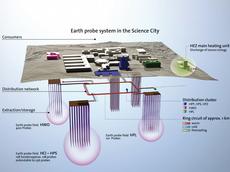On the way to a sustainable energy future
ETH Zurich has a world class reputation in energy research. The university is also treading new ground towards a more sustainable energy future in practice. It will be connecting the first building to the geothermal system at the Hönggerberg location. Optimising operations at all buildings is just as important in order to reduce energy needs and CO2 emissions.
The Hönggerberg campus is still generating considerable CO2 emissions.
This is set to change in the near future. “The new geothermal system currently under
construction is a milestone,” says Dominik Brem, the head of the environment
section at ETH Zurich’s Safety, Security, Health and Environment unit (SSHE).
The system is quite sophisticated: the waste heat given out during cooling in the summer is stored in subterranean storage tanks up to 200 metres below ground and reused for heating purposes in the winter. According to Brem, the key factor here is that the heat and cooling needs can be considered together in an interconnected system. Thanks to this innovative concept, the buildings on the Hönggerberg are scheduled to be heated and cooled with practically zero CO2 emissions by 2025.
The first underground storage tank goes into operation
The supply ring that is intended to connect the heating and cooling circuits of the buildings at the Hönggerberg location is almost complete. Three different lines of up to 50 centimetres thick have been laid and the first storage tank will go into operation in the autumn. The physics buildings HPZ and HPP will be the first buildings of the Science City to be connected to the earth probe system (see gallery).
ETH Zurich is thus making a major step towards an energy-friendly and CO2-neutral campus. This is very appropriate for an institution with a world class reputation in energy research. But what’s the situation in-house as regards energy needs and CO2 emissions?
After the energy consumption per energy reference area and user increased until 2004, these two key figures have been on the decrease ever since. «In absolute terms, electricity requirements are increasing, but we need less per person at ETH Zurich and we are consuming the energy more efficiently», explains Dominik Brem. By contrast, consumption of fossil fuels and direct CO2 emissions are both in decline at ETH Zurich.
Heat from the river Limmat
But where does the electrical and thermal energy ETH Zurich needs actually come from? The electricity is supplied almost entirely by the City of Zurich’s electricity utility. Only 0.25 percent comes from photovoltaic systems on ETH-Zurich buildings (the proportion of photovoltaics for the whole of Switzerland’s electricity production is currently about 0.1 percent).
The two ETH-Zurich locations of Zentrum and Hönggerberg differ
in their heat supplies: in Zentrum, the Walche heat pump, which uses water from
the river Limmat and cools it by 0.7 degrees, covers around two thirds of the
heat requirement. The rest is supplied as district heating from the Hagenholz
refuse incineration plant via steam piping or comes from the recovery of waste
heat.
On the Hönggerberg, heat is produced via a gas boiler (the combined heat and power units that provided heat and electricity are out of operation since 2011 as they are not compatible with the new energy concept on the Hönggerberg).
Optimising operations: an ongoing task
ETH Zurich is marked by relatively high power consumption levels – mainly due to its research activities, which sometimes require a lot of power. “The demand for computing power and the need for server capacities will continue to rise,” says Wolfgang Seifert, ETH Zurich’s Energy Officer. Today, already twenty-five to thirty percent of the electrical energy is needed to operate and cool the servers. The proportion of the electricity requirement for the cooling units is estimated at ten percent – a figure Seifert is also expecting to increase further.
“Improving the efficiency of the cooling units is an ongoing task,” he says. The waste heat given off in the process could be put to even better use. Unlike on the Hönggerberg, however, in Zentrum using the waste heat sensibly is easier said than done. When the cooling requirement is particularly high in the summer, there is practically no need for heat.
LED lighting on the Hönggerberg
At ten percent, the lighting makes a major dent in the electricity consumption. As the buildings are generally fitted with lamps on a very individual basis, however, the improvements here have been few and far between, says Seifert. But if the chance were to come up for a complete renovation, like in the parking garage on the Hönggerberg, it would be taken, of course. Another example of this is the new and very efficient LED lighting in the main building. The next major project is to replace the thirty-year-old outdoor lighting on the Hönggerberg with LED lamps.








READER COMMENTS